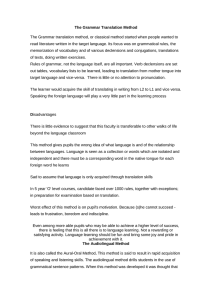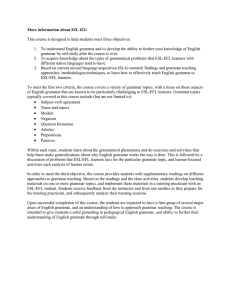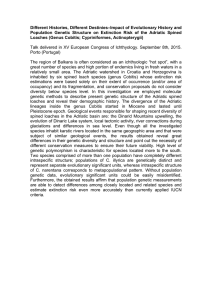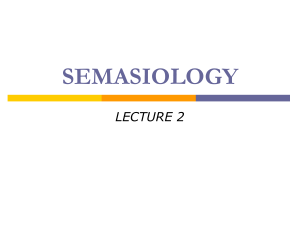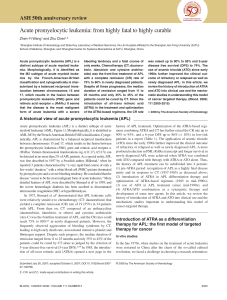Manuel Alfonseca`s Web Page
Anuncio
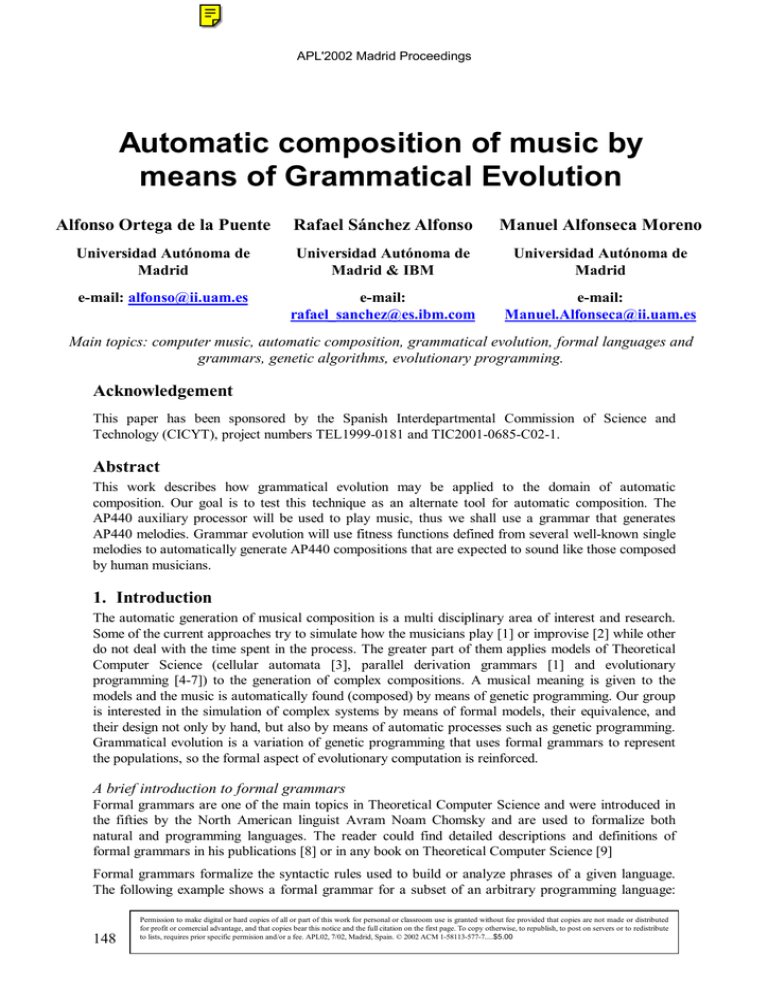
APL'2002 Madrid Proceedings
Automatic composition of music by
means of Grammatical Evolution
Alfonso Ortega de la Puente
Rafael Sánchez Alfonso
Manuel Alfonseca Moreno
Universidad Autónoma de
Madrid
Universidad Autónoma de
Madrid & IBM
Universidad Autónoma de
Madrid
e-mail: alfonso@ii.uam.es
e-mail:
rafael_sanchez@es.ibm.com
e-mail:
Manuel.Alfonseca@ii.uam.es
Main topics: computer music, automatic composition, grammatical evolution, formal languages and
grammars, genetic algorithms, evolutionary programming.
Acknowledgement
This paper has been sponsored by the Spanish Interdepartmental Commission of Science and
Technology (CICYT), project numbers TEL1999-0181 and TIC2001-0685-C02-1.
Abstract
This work describes how grammatical evolution may be applied to the domain of automatic
composition. Our goal is to test this technique as an alternate tool for automatic composition. The
AP440 auxiliary processor will be used to play music, thus we shall use a grammar that generates
AP440 melodies. Grammar evolution will use fitness functions defined from several well-known single
melodies to automatically generate AP440 compositions that are expected to sound like those composed
by human musicians.
1. Introduction
The automatic generation of musical composition is a multi disciplinary area of interest and research.
Some of the current approaches try to simulate how the musicians play [1] or improvise [2] while other
do not deal with the time spent in the process. The greater part of them applies models of Theoretical
Computer Science (cellular automata [3], parallel derivation grammars [1] and evolutionary
programming [4-7]) to the generation of complex compositions. A musical meaning is given to the
models and the music is automatically found (composed) by means of genetic programming. Our group
is interested in the simulation of complex systems by means of formal models, their equivalence, and
their design not only by hand, but also by means of automatic processes such as genetic programming.
Grammatical evolution is a variation of genetic programming that uses formal grammars to represent
the populations, so the formal aspect of evolutionary computation is reinforced.
A brief introduction to formal grammars
Formal grammars are one of the main topics in Theoretical Computer Science and were introduced in
the fifties by the North American linguist Avram Noam Chomsky and are used to formalize both
natural and programming languages. The reader could find detailed descriptions and definitions of
formal grammars in his publications [8] or in any book on Theoretical Computer Science [9]
Formal grammars formalize the syntactic rules used to build or analyze phrases of a given language.
The following example shows a formal grammar for a subset of an arbitrary programming language:
148
Permission to make digital or hard copies of all or part of this work for personal or classroom use is granted without fee provided that copies are not made or distributed
for profit or comercial advantage, and that copies bear this notice and the full citation on the first page. To copy otherwise, to republish, to post on servers or to redistribute
to lists, requires prior specific permision and/or a fee. APL02, 7/02,$OIRQVR
Madrid, Spain.
© 2002 ACM5DIDHO
1-58113-577-7....$5.00
2UWHJD
6iQFKH] DQG 0DQXHO $OIRQVHFD
APL'2002 Madrid Proceedings
the sentences that assign an arithmetic expression to a numeric variable. Let us suppose that the
allowed operations are ), +, ó and ô, and the valid operands are numbers and variables which are
named by vowels. The first word of an assignment must be the name of the variable, the second must be
the symbol » and the rest of the statement is the expression whose value is assigned. The following
sentences are correct assignments:
_»0ó_
`»_ó&143)`'
A formal grammar could describe the structure of the assignment in this way:
Psjc /8 ?qqgelkclr gq T_pg_`jc » ?pgrfkcrgaCvnpcqqgml
Where the words ?qqgelkclr, T_pg_`jc and ?pgrfkcrgaCvnpcqqgml will be further
defined and will not be written like this in the final assignment. The symbol » must literally appear.
Variables' names could be described by the grammar by means of the rule
Psjc 08 T_pg_`jc gq _ mp c mp g mp m mp s
Arithmetic expressions follows the rule
Psjc 18 ?pgrfkcrgaCvnpcqqgml gq L_kc mp T_pg_`jc mp &?pgrfkcrgaCvnpcqqgml'
mp ?pgrfkcrgaCvnpcqqgml Mncp_rgml ?pgrfkcrgaCvnpcqqgml
Where numbers are written in the usual way and operations are defined as follows:
Psjc 28 Mncp_rgml gq ) mp + mp ó mp ô
The structure of the first example could be described by means of the successive application of these
rules. Figure 1 shows the process.
?qqgelkclr
Rule 1
T_pg_`jc
?pgrfkcrgaCvnpcqqgml
Rule 2
Rule 3
?pgrfkcrgaCvnpcqqgml
Rule 3
Mncp_rgml
?pgrfkcrgaCvnpcqqgml
Rule 3
Rule 4
Lsk`cp
T_pg_`jc
Rule 2
_
»
0
ó
_
Figure 1: A grammar is used to analyze the assignment _»0ó_
There are several kinds of grammars. This example shows a Chomsky grammar that does not depend
on the context (a context free grammar). All the grammars used in this paper are context free.
A brief introduction to musical parameters
In the following paragraphs, some essential musical theory concepts will be reviewed. Melody, rhythm
and harmony are considered the three fundamental elements in music. This work is focused on melody.
Melody is a series of musical silences and sounds (or notes) with different lengths and stress arranged
in succession in a particular rhythmic pattern to form a recognizable unit.
Notes' names belong to {A, B, C, D, E, F, G}. These letters represent musical pitches and correspond
to the white keys on the piano. The black keys on the piano are used to play sharp or flat notes. From
left to right, the key that follows any white one is its sharp key and the previous key is its flat key. The
$XWRPDWLF FRPSRVLWLRQ RI PXVLF E\ PHDQV RI *UDPPDWLFDO (YROXWLRQ
149
APL'2002 Madrid Proceedings
name of these keys adds respectively the symbols # and to the white key's name (for example A# or
B). The interested reader could find an amusing simulation of a virtual keyboard at [20].
The distance from a note to its flat or sharp notes is called "a half step" and is the smallest unit of pitch
used in the piano, where there is a half step between every pair of adjacent keys, no matter their color.
Two consecutive half steps are called a whole step.
The maximum length of notes and rests is considered the unit. There are seven different lengths (from 1
to 1/64), each of which has double duration than the next: complete, half, quarter, quaver, semi quaver,
quarter quaver and half quarter quaver. The complete specification of notes and silences includes their
lengths.
An interval is the number of half steps between two notes.
A brief introduction to genetic algorithms
The following paragraphs are extracted from the excellent work on heuristics by Z. Michalewicz and D.
Fogel [19] The interested reader could find a more detailed introduction to this topic in any general text
on evolutionary computation, genetic programming or heuristics.
Genetic algorithms provide a computational model inspired by the evolutionary process of natural
competition and selection. When trying to solve a problem, genetic algorithms starts with a population
of initial candidate solutions usually generated at random and represented as strings of symbols. A
proper evaluation or fitness function is defined to measure how good is a solution. Those solutions
which are better, as determined by the fitness function, become the parents for the next generation of
offspring that replace the discarded individuals. Gene transmission (crossover), mutation and other
biological processes can be implemented in genetic algorithms as string operations: two new individuals
may be obtained from their two parents by taking the first half of one parent and the second half of the
other; an individual may be mutated by randomly changing some symbol.
With each generation, the individuals compete for inclusion in the next iteration. After a series of
generations, it is expected that the quality of the tested solution converges toward a nearly optimum
solution to the problem.
A brief Introduction to grammatical evolution
Grammatical evolution [10-17] is a grammar based, linear genome system, which has been applied in
the area of automatic programming to automatically generate programs or expressions in a given
language to solve a particular problem. Programming languages can be represented usually by context
free Chomsky languages. In grammatical evolution, the Backus Naur Form (BNF) specification of a
language is used to describe the output produced by the system (a compilable code fragment). Different
BNF grammars can be used to automatically produce code in any language.
In grammatical evolution, the genotype is a string of binary numbers (each of which is named codon)
generated at random, treated as integer values. The phenotype is a running computer program generated
by a genotype-phenotype mapping process. The mapping benefits from genetic code degeneracy; i.e.
different integers in the genotype generate the same phenotype.
The genotype-phenotype mapping in grammatical evolution is deterministic; i.e. each individual is
always mapped to the same phenotype. Two mechanisms can be used to minimize the numbers of
invalid individuals in each generation: punishing them with poor fitness values, or using a steady state
replacement method [15, 16]. The last method seems to improve greatly the performance of the
algorithm.
Figure 2 shows a scheme of the process as a biological metaphor. Grammar evolution adds a
grammatical translation level (genotype to phenotype mapping) to classic genetic algorithms: genetic
operators act on genotypes while fitness function evaluates phenotypes.
150
$OIRQVR 2UWHJD 5DIDHO 6iQFKH] DQG 0DQXHO $OIRQVHFD
APL'2002 Madrid Proceedings
This technique has been successfully applied to the automatic programming of problems in different
domains: symbolic regressions, finding trigonometric identities, the Santa Fe ant trail, and caching
algorithms. Our group has previously applied grammatical evolution in the domain of fractal curves.
Figure 2: Grammar evolution layout
2. Music and APL2
APL2 provides the auxiliary processor AP440 to easily create music from the PC speaker. The reader
can find a description of AP440 in any IBM PC APL2 manual [18].
The auxiliary processor interprets as music every character string assigned to the shared variable with
the following syntax:
6+5←t^>WHPSR@>RFWDYH@>PRGH@>OHQJWK@>QRWH@>SDXVH@`gt
Where
WHPSR 7QQ WR GHIDXOW /HQJWK /QQ WR GHIDXOW 2FWDYH 2Q>^ `@Q WR GHIDXOW 1RWH WRQH>^ `@>Q@>@
WRQH $ WR * Q WR GHIDXOW 0RGH 0QQ WR GHIDXOW 3DXVH 3>Q@>@Q WR GHIDXOW $XWRPDWLF FRPSRVLWLRQ RI PXVLF E\ PHDQV RI *UDPPDWLFDO (YROXWLRQ
151
APL'2002 Madrid Proceedings
3. Description of the experiment
The goal of this paper is to automatically generate melodies that sound like those composed by human
authors. First, several well-known compositions will be selected and translated into AP440 melodies.
Then, a set of n parameters will be extracted from the melodies and studied; each melody will become a
vector whose components will be the selected parameters. Our purpose is to identify a combination of
parameters and values that will distinguish random and hand-made melodies. We expect that a melody
whose parameters are close to the values typical for melodies composed by humans will sound like
these melodies. Finally, grammar evolution will be used to automatically generate melodies with the
characteristics previously described. This step involves the specification of a fitness function that will
be based on the distance between the target parameters and the candidate melodies’ vector.
A grammar for AP440's music
In order to solve this problem by means of grammatical evolution we have defined a formal grammar to
express compositions.
The following Chomsky grammar generates AP440 music. The grammar is expressed in BNF (BakusNaur Form) and uses the following conventions:
•
Angular brackets embrace non-terminal symbols, expressions that do not belong to the language of
AP440 compositions, but can be replaced by other symbols to generate correct AP440 melodies
(for example <Composition>).
•
Names not embraced by angular brackets represent terminal symbols, expressions that can belong
to an AP440 composition, and cannot be replaced by any symbol. They will appear literally in the
final composition.
•
The derivations of the grammar are represented in the following way:
<Non terminal>::=Expression
•
Where Expression is a string of terminal and non terminal symbols
•
The symbol | replaces the word "or" used in the first example of a formal grammar.
•
The right hand side of several rules is followed by parenthesized real numbers. These rules are
probabilistic and their numbers show the probability for each option to be chosen.
•
7KH V\PERO
0
VWDQGV IRU WKH HPSW\ ZRUG D ZRUG ZLWKRXW V\PEROV DQG LW LV XVHG WR HUDVH QRQ
terminal symbols.
&RPSRVLWLRQ! 1RWH!_
1!
&RPSRVLWLRQ!1RWH!
1RWH! 7!2!0!/!1!
7!
_ 7Q!
Q! ______
2!
2!
0!
_ 2 2!Q!
_ _ _ 0Q!
Q! __
/!
152
_B1RWH!_
3DXVH!
B1RWH! 6RXQG!
B1!Q!'RW!
6RXQG! $_%_&_'_(_)_*
B1!
_6KDUS!_)ODW!
6KDUS! _
)ODW! 'RW!
_
3DXVH! 3Q!'RW!
_ /Q!
$OIRQVR 2UWHJD 5DIDHO 6iQFKH] DQG 0DQXHO $OIRQVHFD
APL'2002 Madrid Proceedings
Description of the GE algorithm implementation
Initial population
The initial population has 64 vectors of 32 random codons (integer numbers from the interval [0,255]).
A length equal to thirty-two seems to be suitable for the genotypes.
Genetic operators
The classic genetic operators crossover and mutation are extended with an enlarging operator (that
splices the genotype and another string of codons) and a cutting operator (that removes some of the
codons).
The number of discarded individuals from a generation to another is 16, that is, 25% of the whole
population. They are replaced by the offspring of the 16 better genotypes randomly coupled. Crossover
is made at a single random position. If both parents are the same, the probability of mutation is 0.95
otherwise it is 0.25. When an individual mutates, each of its codons is randomly changed with a
probability of 0.25.
The probability for an offspring to be enlarged with one of its parents is 0.05 and the probability to be
reduced is 0.05 too.
Fitness function
As it can be deduced from the AP440 syntax, there are 83 valid different notes with 7 possible lengths.
In this work, both notes and lengths are identified by means of natural numbers taken respectively from
the intervals [0, 82] and [0, 6]. Among other possible parameters we intend to consider those extracted
from three random variables: the pitch and the differences between consecutive notes and lengths that
belong to the sets [-82, 82] and [-6, 6]. Melodies are quantified as vectors with some measures
computed from these three variables.
APL2 implementation
GEMUSIC is the main function and executes the following steps:
[1]
Create the AP440 grammar
[2]
Generate the initial population of genotypes.
[3]
Evaluate the fitness function on every new phenotype.
[4]
Sort the population of genotypes by their merit.
[5]
Replace the worse individuals by the offspring of the better.
[6]
Go to step [3] until finding a good enough solution.
The APL2 functions MKGRMMR, GENER, TEST and SEX called by GEMUSIC are used to
respectively solve the steps [1], [2], [3] and [5].
Listing 1 shows GEMUSIC’s code.
Y.[ X»ECKSQGA E9G9N9T9GM9Ep_kk_p]9NpmbsargmlPsjcq]9Rcpkgl_jq]9K?VDGR
Y/[
GM»/
Y0[
Ep_kk_p]»KIEPKKP
â ?N22. ep_kk_p gq apc_rcb
Y1[
NpmbsargmlPsjcq]»EPK0PSJC Ep_kk_p] â _lb grq amknmlclrq _pc cvrp_arcb
Y2[
Rcpkgl_jq]»EPK0RPK Ep_kk_p]
Y3[
Lmr_?Lsk]»KILR0LSK
Y5[
K?VDGR»/...
â Dgrlcqq md rfc r_pecr kcjmbw
Y6[
GM»E».
Y7[ N»ECLCPü42ä10
â Glgrg_j nmnsj_rgml gq eclcp_rcb
Y/.[ T»RCQRüN
â Asppclr nmnsj_rgml gq ct_js_rcb
Y//[ J8T»TYG»úT[
â Asppclr nmnsj_rgml gq qmprcb
Y/0[ N»NYG[
Y/1[ %ECLCP?RGML%&E»E)/'%K?V ;%&ÄT'&RP?LQÄN' â ? kcqq_ec gq npmknrcb
$XWRPDWLF FRPSRVLWLRQ RI PXVLF E\ PHDQV RI *UDPPDWLFDO (YROXWLRQ
153
APL'2002 Madrid Proceedings
Y/2[
Y/3[
Y/4[
Y/5[
Y/6[
Y/7[
¶&K?VDGRñÄT'-D
NY26)ê/4[»QCV NY/4=/4[
TY26)ê/4[»RCQRüNY26)ê/4[
¶J
D8XȀN
â
â
â
â
â
â
Gd rfc `crrcp glbgtgbs_j gq gl rfc
`_jj rfc npmacqq dglgqfcq
Umpqc glbgtgbs_jq _pc pcnj_acb
_lb rfcgp kcpgr gq snb_rcb
Lcvr grcp_rgml
@cqr eclmrwnc gq pcrsplcb
Listing 1: Current function GEMUSIC’s code
4. Further research
The goal of our future experiments will be to automatically compose melodies with the style and flavor
of well-known composers. Thus, the work described in this paper will be extended in the following way:
•
Select several well-known composers and a set of distinctive melodies from their compositions and
express them with AP440 syntax.
•
Identify a combination of the compositions’ parameters that will distinguish and cluster the
melodies of each composer.
•
Automatically generate a melody with the style of a given composer by means of grammar
evolution.
•
Each composer’s set of melodies will be represented by the vector of the arithmetic average of the
coordinates of the set. The fitness function is based on the Euclidean distance from this average
vector to each individual candidate.
Figure 3 graphically shows the goal of the process: several composers' populations are represented as
points in a two-dimensional landscape. A distinctive point is emphasized in each population. A ball
surrounds the target composer’s population. The dotted arrow shows the expected path followed by the
best melody from a random beginning place in the plane until one of its descendants reaches the ball.
Figure 3: Grammar evoution and music layout
5. References
1. J. MCCORMACK, 1996 Grammar-based music composition. In Complex International Vol 3
2. J. BILES, 1994 GenJam: A Genetic Algorithm for Generating Jazz Solos. In Proceedings of the
1994 International Computer Music Conference, ICMA, San Francisco, 1994
3. E. BILOTTA, P. PANTANO, V. TALARICO, 2000 Synthetic Harmonies: an approach to musical
semiosis by means of cellular automata. In Artificial Life VII: Proceedings of the Seventh
International Conference, edited by M. Beday et al. MIT Press.
154
$OIRQVR 2UWHJD 5DIDHO 6iQFKH] DQG 0DQXHO $OIRQVHFD
APL'2002 Madrid Proceedings
4. D. LIDOV, J. GABURA, 1973 A melody writing algorithm using a formal language model, in
Computer Studies in the Humanities 4(3-4), pp. 138-148, 1973
5. P. LAINE, M. KUUSKANKARE, 1994 Genetic Algorithms in Musical Style oriented Generation in:
Proceedings of the First IEEE Conference on Evolutionary Computation, Orlando, Florida, 1994.
6. D. HOROWITZ, 1994 Generating Rhythms with Genetic Algorithms, in: Proceedings of the ICMC
1994, International Computer Music Association, Århus, 1994
7. B. JACOB, 1994 Composing with Genetic Algorithms In Proceedings of the 1995 International
Computer Music Conference, ICMA, San Francisco.
8. N. CHOMSKY, 1956 Three models for the description of a language IRE Transaction on
Information Theory. 2:3 113-124.
9. J.E. HOPCROFT, R. MOTWANI, J. D. ULLMAN, 2001 Introduction to Automata Theory,
Languages, and Computation. Pearson Education.
10. M. O'NEILL AND C. RYAN: Grammatical Evolution. IEEE Transaction on Evolutionary
Computation. August 2001. Vol. 5, number 4 ITEVF5 (ISSN 1089-779X)
11. M. O'NEILL AND C. RYAN: Evolving Multi-line Compilable C Programs. In Proceedings of the
Second European Workshop on Genetic 1999. Berlin, Germany: Springer-Verlag, 1999, vol. 1598,
LNCS, pp. 83-92
12. M. O'NEILL AND C. RYAN: Under the Hood of Grammatical Evolution. In GECCO '99:
Proceedings of the Genetic and Evolutionary Computation Conference 1999, W. Banzhaf et al.
Eds. San Mateo, CA: Morgan Kaufmann, 1999, vol. 2, pp. 1143-1148
13. M. O'NEILL AND C. RYAN: Genetic code degeneracy: implications for grammatical evolution and
beyond. In ECAL'99: Proceedings of the Fifth European Conference on Artificial Life, Lausanne,
Switzerland, Sept. 1999, pp. 149-153
14. RYAN, J.J. COLLINS, AND M. O'NEILL: Grammatical Evolution: Evolving Programs for an
Arbitrary Language. In EuroGP'98: Proceedings of the First European Workshop on Genetic
Programming. Berlin, Germany: Springer-Verlag, 1998, vol.. 1391, LNCS, pp. 83-95
15. RYAN, O'NEILL M. Grammatical Evolution: A Steady State Approach. In Late Breaking Papers,
Genetic Programming 1998, pages 180-185.
16. RYAN, M. O'NEILL: Grammatical Evolution: A Steady State Approach. In Genetic Programming
1998: Proceedings of the 3rd Annual Conference, J. R. Koza et al. Ed.s Cambridge, MMA, 1998,
pp. 180-185
17. C. RYAN, M. O'NEILL, AND J. J. COLLINS: Grammatical Evolution: Solving Trigonometric
Identities. In Mendel'98: Proceedings of the 4th International Conference on Genetic Algorithms,
Optimization Problems, Fuzzy Logic, Neural Networks, and Rough Sets. Brno, Czech Republic:
Tech. Univ. Brno, 1998, pp. 111-119
18. IBM: APL2 for the IBM PC: Reference summary Version 1.02. IBM Scientific Centres Madrid,
Spain and Winchester, England. SC33-0601-01. Nov. 8, 1991.
19. Z. MICHALEWICZ, D. FOGEL: How to solve it: modern heuristics. Springer-Verlag Berlin
Heidelberg, 2000
20. M. MONCUR: THE WWW VIRTUAL KEYBOARD,
http://www.xmission.com/~mgm/misc/keyboard.html
$XWRPDWLF FRPSRVLWLRQ RI PXVLF E\ PHDQV RI *UDPPDWLFDO (YROXWLRQ
155
